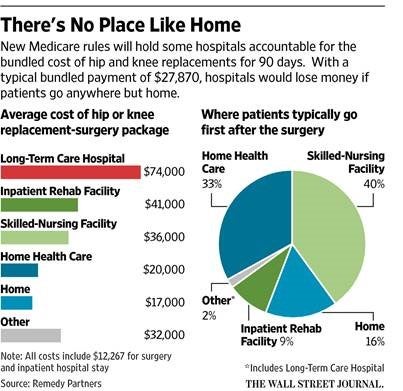After seeing this headline in the news: “CMS Announces Bundled Payments for Joint Replacement Surgery”, my neighbor told me that he was going to need to hurry to have his new knee replacement done now that outpatient rehab was being phased out under Medicare. I reassured him that outpatient rehab was not going away. I explained that there were simply changes in the payment model.
CMS began with the Comprehensive Care for Joint Replacement Model. Historically, hip and knee replacements have been among the most common surgeries for patients with Medicare. These surgeries require “lengthy recovery and rehabilitation periods” and have had a wide range of clinical practice patterns with variable cost and outcomes. (innovation.cms.gov/initiatives) In response, CMS established a bundled reimbursement model for these total joint replacements. Of note, UVA is not presently affected by this CMS initiative yet.
Finding the model to be successful within orthopedics so far, the Centers for Medicare & Medicaid Services (CMS) recently announced plans to bundle payments for all care associated with cardiac bypass surgery and heart attacks. This is in addition to an expansion of current bundled payments for total hip and knee replacements. CMS notes: “Research has shown that bundled payments can align incentives for providers – hospitals, post-acute care providers, physicians, and other practitioners – allowing them to work closely together across all specialties and settings” (CMS. gov).
Bundled payments will cover providers and the facilities from admission through 90 days of post-acute/rehab care. (This is compared to a fee-for-service model, where physician fees and facilities charges are paid for separately.)
According to Dr. James Browne, UVA’s “Guru of Orthopedic Bundle Payments”: “Episode based bundled payment models present opportunities as well as challenges. These models can align incentives around the common goal of coordinating care and improving quality and cost-efficiency. However, without satisfactory risk adjustment, bundled payment programs can penalize tertiary care centers like UVA that treat more complex patients. The general consensus is that bundled payments are here to stay, so we are working proactively to understand how we can be successful under this new paradigm.”
Dr. Browne refers to an image from the Wall Street Journal below.

Philosophically, bundle payments uses an approach that minimizes variability and drives quality improvement while lowering the cost of care. It also fits into the service-line model that UVA is adopting.
For an academic center, this will requires both supervision and early escalation of issues identified by staff and trainees to ensure safe and efficient care.
That’s where we are now.
-cg
Thanks to Posy Marzani and Jack Jackson for their help with this blog.
Filed Under: Staff

Comments